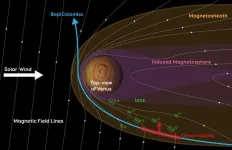(Press-News.org) A deep dive into macroalgae genetics has uncovered the genetic underpinnings that enabled macroalgae, or “seaweed,” to evolve multicellularity. Three lineages of macroalgae developed multicellularity independently and during very different time periods by acquiring genes that enable cell adhesion, extracellular matrix formation, and cell differentiation, researchers report April 12 in the journal Molecular Plant. Surprisingly, many of these multicellular-enabling genes had viral origins. The study, which increased the total number of sequenced macroalgal genomes from 14 to 124, is the first to investigate macroalgal evolution through the lens of genomics.
“This is a big genomic resource that will open the door for many more studies,” says co-first author and algal biologist Alexandra Mystikou of New York University Abu Dhabi and the Technology Innovation Institute, United Arab Emirates. “Macroalgae play an important role in global climate regulation and ecosystems, and they have numerous commercial and ecoengineering applications, but until now, there wasn't a lot of information about their genomes.”
Macroalgae live in both fresh and seawater and are complex multicellular organisms with distinct organs and tissues, in contrast to microalgae, which are microscopic and unicellular. There are three main groups of macroalgae—red (Rhodophyta), green (Chlorophyta), and brown (Ochrophyta)—that independently evolved multicellularity at very different times and in very different environmental conditions. Rhodophytes and Chlorophytes both evolved multicellularity over a billion years ago, while Ochrophytes only became multicellular in the past 200,000 years.
To investigate the evolution of macroalgal multicellularity, the researchers sequenced 110 new macroalgal genomes from 105 different species originating from fresh and saltwater habitats in diverse geographies and climates.
The researchers identified several metabolic pathways that distinguish macroalgae from microalgae, some of which may be responsible for the success of invasive macroalgal species. Many of these metabolic genes appear to have been donated by algae-infecting viruses, and genes with a viral origin were especially prevalent in the more recently evolved brown algae.
They found that macroalgae acquired many new genes that are not present in microalgae on their road to multicellularity. For all three lineages, key acquisitions included genes involved in cell adhesion (which enables cells to stick together), cell differentiation (which allows different cells to develop specialized functions), cell communication, and inter-cellular transport.
“Many brown algal genes associated with multicellular functions had signature motifs that were only otherwise present in the viruses that infect them,” says co-first author and bioinformatician David Nelson of New York University Abu Dhabi. “It's kind of a wild theory that’s only been hinted at in the past, but from our data it looks like these horizontally transferred genes were critical factors for evolving multicellularity in the brown algae.”
The team also identified other features that were distinct between the macroalgal lineages. They observed much more diversity between different species of Rhodophyte, which evolved multicellularity first and have thus had longer to diverge. They also found that Chlorophytes share many genomic features with land plants, suggesting that these genes may have already been present in the last common ancestor of Chlorophytes and plants.
“By no means have we exhaustively explored all that there is in these genomes,” says senior author and systems biologist Kourosh Salehi-Ashtiani of New York University Abu Dhabi. “There is a ton of information that we have not touched in the present paper that can be mined by whoever who is interested.”
The researchers are already digging into the dataset to investigate environmental and habitat adaptations amongst macroalgae. In future, they hope to sequence and analyze even more macroalgal genomes.
“We want to explore some of these features in more detail, meaning more genomes if we can get our hands on them,” says Salehi-Ashtiani.
###
This research was supported by the NYUAD Faculty Research Funds and Tamkeen.
Molecular Plant, Nelson and Mystikou et al., “Macroalgal deep genomics illuminate multiple paths to aquatic, photosynthetic multicellularity” https://www.cell.com/molecular-plant/fulltext/S1674-2052(24)00084-4
Molecular Plant, published by Cell Press for the Center for Excellence in Molecular Plant Sciences (Shanghai), Chinese Academy of Sciences, and Chinese Society of Plant Biology, is a monthly journal that focuses broadly on plant science, including cellular biology, physiology, biochemistry, molecular biology, genetics, development, plant-microbe interaction, genomics, bioinformatics, and molecular evolution. All contents are freely available starting 12 months after publication. Visit http://www.cell.com/molecular-plant. To receive Cell Press media alerts, contact press@cell.com.
END
Melanoma is the deadliest form of skin cancer. With global incidence rates rising, new, more effective treatments are necessary to alleviate the health burden of the disease. Important advances in recent years include doctors using genetic tests to look for specific mutations they can target for more personalised, effective treatment.
Around 1 in 2 melanoma patients will have mutations in the BRAF gene. This gene normally makes a protein which helps control cell growth, but mutations can cause the cells to grow and divide uncontrollably instead, happening in many different types of cancer including ...
It is one of the world’s most spectacular sights – huge flocks or “flamboyances” of flamingos around East Africa’s lakes – as seen in the film Out of Africa or David Attenborough’s A Perfect Planet.
But new research led by King’s College London has revealed how the lesser flamingo is at danger of being flushed out of its historic feeding grounds, with serious consequences for the future of the species.
For the first time satellite earth observation data has been used to study all the key flamingo feeding lakes in Ethiopia, Kenya and Tanzania over two decades and it identified how rising ...
About The Study: In this study of National Immunization Survey–Child data, improvements in vaccination timeliness were observed from the 2011 to the 2021 survey. However, widening disparities by socioeconomic indicators signal that increased efforts to facilitate timely vaccination among children in lower-income families are needed.
Authors: Sophia R. Newcomer, Ph.D., M.P.H., of the University of Montana, Missoula, is the corresponding author.
To access the embargoed study: Visit our For The Media website at this ...
About The Study: Researchers observed an abrupt increase in permanent contraception procedures among adults ages 18 to 30 following Dobbs. The increase in procedures for female patients was double that for male patients. These patterns offer insights into the gendered dynamics of permanent contraceptive use and may reflect the disproportionate health, social, and economic consequences of compulsory pregnancy on women and people with the capacity to become pregnant.
Authors: Jacqueline E. Ellison, Ph.D., of the University of Pittsburgh School of Public Health, is the corresponding author.
To access the embargoed study: Visit our For The Media website ...
About The Study: The results of this study suggest that endoscopic sleeve gastroplasty is cost saving compared with semaglutide in the treatment of class II obesity. On price threshold analyses, a 3-fold decrease in the price of semaglutide is needed to achieve nondominance.
Authors: Christopher C. Thompson, M.D., M.Sc., of Brigham and Women’s Hospital in Boston, is the corresponding author.
To access the embargoed study: Visit our For The Media website at this link https://media.jamanetwork.com/
(doi:10.1001/jamanetworkopen.2024.6221)
Editor’s Note: Please ...
The first study to evaluate the effect of the Dobbs v. Jackson Women's Health Organization ruling on permanent contraception procedures among young adults nationwide was published today in a JAMA Health Forum research letter.
The study, authored by policy researchers from the University of Pittsburgh School of Public Health and Boston University, underscores how the 2022 U.S. Supreme Court ruling changed preferences for permanent contraception among people ages 18 to 30, who are more likely to have abortions and are also more likely to experience sterilization regret compared to people over 30.
The study is also the first to assess how the Dobbs ruling ...
Approximately one in seven couples face difficulties conceiving a child naturally. Half of these cases are due to male infertility – either caused by the complete absence or low number of mature sperm. In today’s clinical practice, over half of these cases remain unexplained, hindering optimal counselling, treatment, and prevention of potential comorbidities. Known genetic factors account for ~10% of male infertility; however, it is believed that a large portion of unexplained cases of spermatogenic failure are caused by genetic defects that ...
In cellular biology, unraveling the complexities of cellular function at the molecular level remains a paramount endeavor. Significant scientific focus has been placed on understanding the interactions at organelle contact sites, especially between mitochondria and the endoplasmic reticulum (ER). These sites are critical hubs for the exchange of essential biomolecules, such as lipids and calcium, which are vital for maintaining cellular homeostasis. Disruptions in this inter-organelle communication are implicated in the onset ...
A fleeting visit of the ESA/JAXA BepiColombo mission to Venus has revealed surprising insights into how gases are stripped away from the upper layers of the planet’s atmosphere.
Detections in a previously unexplored region of Venus’s magnetic environment show that carbon and oxygen are being accelerated to speeds where they can escape the planet’s gravitational pull. The results have been published today in the journal Nature Astronomy.
Lina Hadid, CNRS researcher at the Plasma Physics Laboratory (LPP) and lead author of the study said: “This is the first time ...
Vancouver, BC – The International Neuromodulation Society (INS) announces its 16th Scientific World Congress in the breathtaking city of Vancouver, Canada, from May 11-16, 2024. This event, "Neuromodulation: Harnessing the Power of the Nervous System," is set to gather over 1,500 experts from over 40 countries –– with researchers presenting more than 460 abstracts –– all dedicated to advancing research, clinical application, and development in the field of neuromodulation.
This multidisciplinary program will draw clinicians, engineers, scientists, post-doctoral fellows, current students, and device manufacturers, and attendees ...




